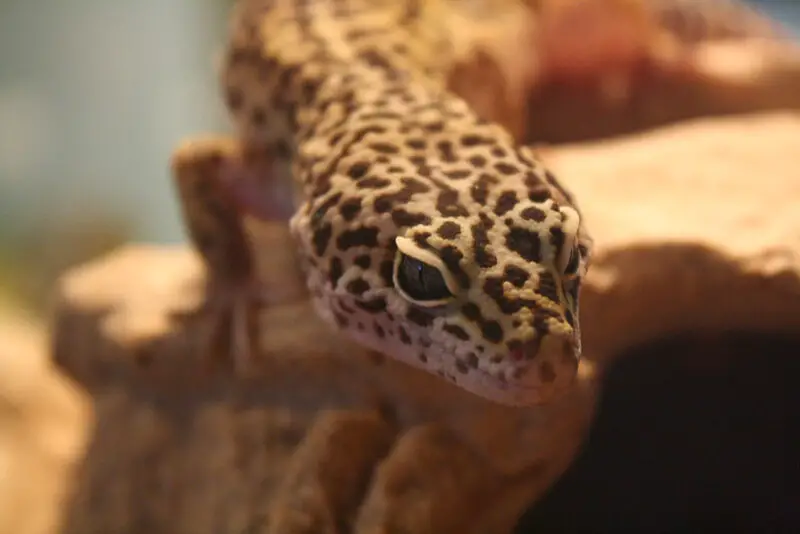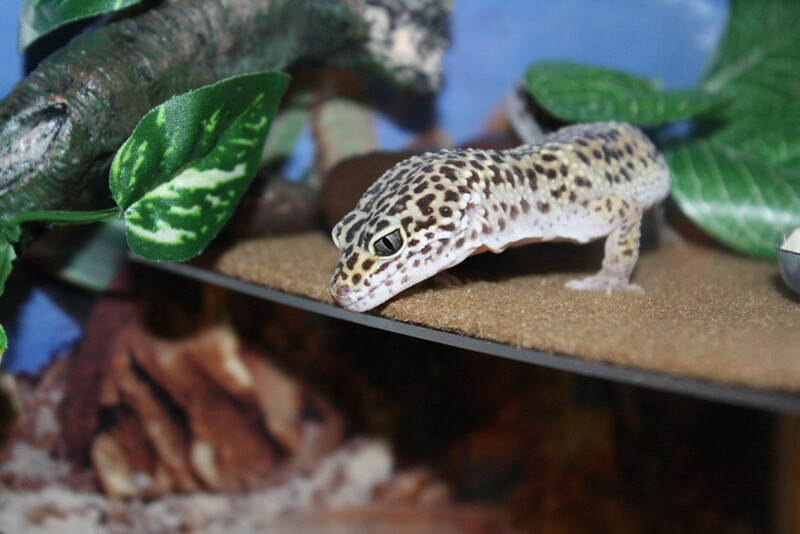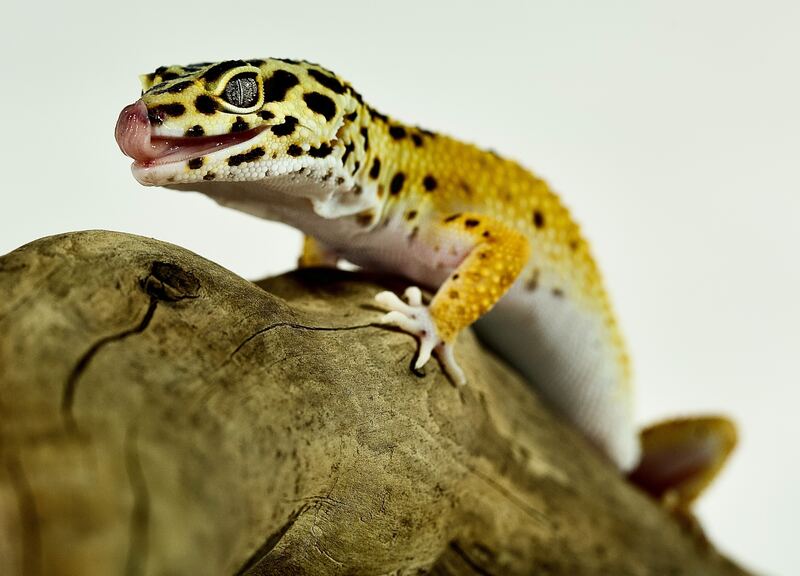Leopard geckos are small, ground-dwelling lizards that originate from arid regions in South Asia, primarily Afghanistan, Pakistan, and northwest India. In captivity, providing an appropriate terrarium is crucial to ensure their health and happiness. Leopard geckos are relatively easy to care for compared to some other reptile species, but their terrarium requirements are specific and must be met to create a suitable habitat.
A well-designed leopard gecko terrarium replicates their natural habitat, providing them with a safe, comfortable, and stimulating environment. In this discussion, we will explore the essential elements that make up a leopard gecko terrarium and the specific requirements they entail.

Terrarium Size
The size of a leopard gecko terrarium is one of the most critical factors to consider when setting up their habitat. A properly sized enclosure provides the geckos with the space they need to move around, thermoregulate, and engage in natural behaviors. Here are some key considerations regarding terrarium size for leopard geckos:
- Minimum Size: For a single adult leopard gecko, the minimum recommended enclosure size is a 10-gallon tank (approximately 20 inches long, 10 inches wide, and 12 inches high). However, larger is always better, and many reptile enthusiasts recommend starting with a 20-gallon long tank for a single adult leopard gecko.
- Multiple Geckos: If you plan to house multiple geckos together, you’ll need a larger enclosure to accommodate their needs. A 20-gallon long tank can house a small group, but it’s crucial to provide additional space for each additional gecko.
- Space for Hiding Spots: Leopard geckos require hiding spots within their enclosure, so make sure to factor these in when determining the size. Adequate hiding spots allow geckos to establish territories and feel secure.
- Vertical Space: Leopard geckos are primarily terrestrial but may occasionally climb. Providing some vertical space within the enclosure can stimulate their natural behaviors, but this is not a strict requirement.
- Breeding Enclosures: Breeding setups may differ, as they should include separate enclosures for the male and female to ensure successful breeding and reduce the chances of overbreeding.
In summary, it’s crucial to consider the size of the enclosure when setting up a leopard gecko terrarium. Providing enough space for their comfort, hiding spots, and potential cohabitants (if applicable) is essential for their overall well-being.
Substrate
The choice of substrate, or bedding, for your leopard gecko’s terrarium is another vital aspect of their enclosure setup. The substrate serves several purposes, including helping to maintain humidity levels, providing a comfortable surface for the geckos, and facilitating waste removal. Here are some commonly used substrates for leopard gecko terrariums:
- Paper Towels or Reptile Carpet: These are simple and easy-to-clean options, making them suitable for beginners. They do not impact humidity levels significantly, but they may lack natural aesthetics.
- Tile or Linoleum: These provide a flat and easily cleanable surface. They can help maintain humidity levels better than some other substrates and mimic the look of arid habitats.
- Cypress Mulch or Coir: These natural substrates retain moisture well, which can help maintain proper humidity levels. However, you should be cautious with humidity, as leopard geckos are desert-dwelling reptiles and require a drier environment.
- Slate or Flagstone: These are used for a naturalistic look, and they also help maintain humidity levels. They offer a relatively flat surface that’s easy to clean.
- Sand (with Caution): Sand can be used as a substrate, but it’s essential to be cautious. Loose, fine sand can cause impaction if ingested by the geckos, which can be a severe health issue. If using sand, choose a coarse, calcium-based sand and monitor your geckos to ensure they’re not ingesting it.
- Bioactive Substrate: Some keepers opt for bioactive substrates, which include living plants and microorganisms to create a self-sustaining ecosystem. While this can be beneficial, it’s more complex and requires more experience.
When selecting a substrate for your leopard gecko, consider factors like ease of maintenance, aesthetics, and your gecko’s specific needs. Always ensure the substrate is kept clean and dry to prevent health issues and maintain a suitable environment.

Temperature and Heating
Leopard geckos are ectothermic, meaning they rely on external sources of heat to regulate their body temperature. Maintaining the correct temperature gradient in their terrarium is crucial for their health and well-being. Here’s what you need to know about temperature and heating for leopard gecko enclosures:
- Basking Spot: Provide a basking spot at one end of the enclosure where the temperature reaches around 88-92°F (31-33°C). This allows geckos to thermoregulate by moving between the warm basking spot and cooler areas.
- Cool Zone: The opposite end of the enclosure should be cooler, with temperatures around 75-80°F (24-27°C). This provides geckos with a cool area to retreat to if they become too warm.
- Nighttime Temperatures: At night, temperatures can drop to 70-75°F (21-24°C). Use a ceramic heat emitter or an under-tank heating pad to provide gentle heat during the night without disturbing their natural day-night cycle.
- Heat Sources: Common heat sources for leopard geckos include overhead heat lamps, ceramic heat emitters, and under-tank heating pads. Ensure that the heat source is appropriately regulated with a thermostat to prevent overheating.
- Thermometers: Use accurate thermometers to monitor temperatures within the enclosure. Digital thermometers with probes are useful for checking temperatures at different levels.
- Avoid Heat Rocks: Do not use heat rocks or other items that can become too hot and potentially burn the geckos.
- Use a Timer: Use a timer for your heat source to establish a consistent day-night cycle.
Maintaining the correct temperature gradient in the terrarium is essential for the geckos’ digestion, metabolism, and overall health. Temperature gradients allow them to choose their preferred temperature and behavior.
Lighting
Leopard geckos are crepuscular and primarily active during dawn and dusk. As a result, they do not require specialized UVB lighting, as they are not heavily reliant on the sun for their vitamin D needs. However, some form of lighting is still necessary for the terrarium to create a natural day-night cycle, provide a heat source (if using a heat lamp), and allow you to observe your geckos.
Here are some key considerations for lighting in leopard gecko terrariums:
- Light Source: Use a low-wattage, incandescent heat lamp or a ceramic heat emitter to provide warmth. These heat sources also produce some visible light, which can serve as a daytime light source.
- Day-Night Cycle: Maintain a regular day-night cycle for your geckos. Aim for around 12 hours of light and 12 hours of darkness. A timer can help automate this cycle.
- Avoid Direct Sunlight: Keep the terrarium away from direct sunlight, as this can cause overheating and create temperature extremes.
- Red or Blue Night Bulbs: Some keepers use red or blue night bulbs to provide dim, nighttime lighting that doesn’t disrupt the geckos’ natural behavior.
- UVB Lighting (Optional): While leopard geckos do not require UVB lighting, providing it may offer some potential health benefits. UVB can help with calcium metabolism and synthesis of vitamin D. If you choose to provide UVB lighting, use a low-output UVB bulb designed for reptiles.
In summary, leopard geckos do not need extensive lighting in their terrariums, but a light source is still essential for maintaining a day-night cycle, providing heat, and allowing observation. It’s important to create a comfortable and appropriate lighting environment for your geckos.
Decor and Enrichment
Leopard geckos may not be as active as some other reptile species, but they still benefit from a well-enriched environment. Providing decor and hiding spots can stimulate natural behaviors, reduce stress, and create a more aesthetically pleasing habitat. Here are some elements you can include in your leopard gecko’s terrarium:
- Hiding Spots: Leopard geckos are known for their love of hiding. Provide multiple hiding spots made of materials like cork bark, half logs, or commercial reptile hides. These hides should be placed at both the warm and cool ends of the enclosure.
- Substrate Accessories: Adding flat stones, pieces of driftwood, or PVC pipes to the substrate can create additional hiding spots and a more diverse landscape for the geckos.
- Live or Artificial Plants: Incorporating live or artificial plants can add visual interest to the terrarium. Live plants can also help maintain humidity levels when appropriately chosen and cared for.
- Climbing Opportunities: While leopard geckos are primarily terrestrial, they may occasionally climb. Provide decor like branches or ledges for them to explore.
- Food and Water Dishes: Use shallow dishes for food and water. Choose ceramic or plastic dishes that are easy to clean.
- Basking Platforms: If you have a basking light, provide a platform or stone beneath it to allow geckos to bask comfortably.
- Substrate Depth: Maintain an appropriate substrate depth (around 2-3 inches) to allow geckos to burrow or dig.
- Environmental Changes: Periodically rearrange or change the decor to provide mental stimulation and reduce boredom. However, avoid frequent, drastic changes that may stress the geckos.
Enriching your leopard gecko’s environment by providing hiding spots, climbing opportunities, and opportunities for exploration can enhance their well-being and keep them mentally and physically active.

Humidity
Leopard geckos are native to arid regions, so maintaining a relatively low humidity level in their terrarium is essential. High humidity can lead to respiratory issues and skin problems in these reptiles. Here are some tips for managing humidity in a leopard gecko enclosure:
- Substrate Choice: Choose a substrate that does not retain excessive moisture. Paper towels, reptile carpet, and slate tiles are good options for maintaining lower humidity levels.
- Water Bowl: Provide a shallow water dish that’s large enough for the geckos to drink from and soak in if they choose. Keep the water dish clean and change the water regularly.
- Misting: Avoid excessive misting of the enclosure, as this can raise humidity levels. Only mist when necessary to maintain proper humidity for shedding.
- Hide Placement: Ensure that hides are not placed directly over the water dish, as this can create localized humidity that may lead to respiratory issues.
- Hygrometer: Use a hygrometer to monitor humidity levels within the enclosure and make adjustments as needed.
- Shedding Assistance: To aid in shedding, you can provide a moist hide by placing a small container filled with damp moss or paper towels in the enclosure. This can help geckos with their shedding process.
Maintaining proper humidity levels is crucial to prevent health issues. Leopard geckos are not well-suited to high humidity environments, so it’s essential to keep their enclosure relatively dry.
Cleaning and Maintenance
Regular cleaning and maintenance of the leopard gecko terrarium are necessary to keep the environment hygienic and prevent health problems. Here are some important cleaning and maintenance tasks to include in your care routine:
- Spot Cleaning: Remove feces and uneaten food daily to prevent the growth of harmful bacteria.
- Substrate Replacement: Depending on the type of substrate you’re using, you’ll need to replace or clean it regularly. Substrate that retains moisture may require more frequent replacement.
- Water Bowl Cleaning: Clean the water dish at least once a week, and change the water as needed.
- Hiding Spot Inspection: Periodically inspect and clean the hiding spots to ensure they remain safe and free from pests.
- Decor Cleaning: Clean and disinfect decor items periodically to prevent the buildup of bacteria.
- UVB Bulb Replacement: If you’re using a UVB bulb, replace it according to the manufacturer’s recommendations.
- Thermostat Checks: Regularly check and calibrate thermostats and temperature control devices to ensure they function correctly.
- Terrarium Reorganization: Periodically rearrange or change the decor to provide mental stimulation and reduce boredom.
Maintaining a clean and well-maintained terrarium is essential for the health and well-being of your leopard geckos. Regular cleaning helps prevent health issues and ensures that the environment remains safe.
Conclusion
Leopard geckos are charming and relatively easy-to-care-for reptile pets, but their terrarium requirements are specific and must be met to ensure their well-being. A properly designed leopard gecko terrarium provides the right amount of space, suitable substrate, proper heating and lighting, hiding spots, and decor to stimulate their natural behaviors.
When setting up a leopard gecko terrarium, consider factors like the size of the enclosure, substrate choice, temperature and heating requirements, lighting, decor and enrichment, humidity management, and cleaning and maintenance tasks. By creating a well-balanced and species-appropriate environment, you can help your leopard geckos thrive and lead healthy, fulfilling lives in captivity.
Always monitor your geckos closely, provide regular veterinary care, and be prepared to make adjustments to their terrarium setup based on their individual needs and preferences. With proper care and attention to their terrarium, you can enjoy the companionship of these unique reptiles for many years.
